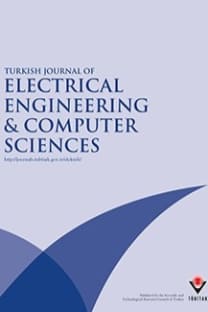Intelligent text classification system based on self-administered ontology
Ontology, support vector machine, resource description framework, text classification
Intelligent text classification system based on self-administered ontology
___
- area, our framework is independent of any specific domain area and purely focused towards user query, picking up the domain at run time. Prefixing of the domain also requires [12] to generate seed ontology first and then proceed towards the enrichment process. Our framework does not have such dependencies, which results in making it a ‘self-governed’ learning system.
- Conclusion and future work
- Christopher CS, Tylman J. Enterprise information portals. Electron Libr 1998; 18: 354–362.
- Sheth A. Computing for human experience: semantics-empowered sensors, services, and social computing on the ubiquitous Web. IEEE Internet Comput 2010; 14: 88–91.
- Sebastiani F. Machine learning in automated text categorization. Comput Surv 2002; 34: 1–47.
- Gupta V, Lehal G. A survey of text mining techniques and applications. Journal of Emerging Technologies in Web Intelligence 2009; 1: 60–76.
- Navigli R, Faralli S, Soroa A, de Lacalle OL, Agirre E. Two birds with one stone: learning semantic models for text categorization and word sense disambiguation. In: 20th ACM Conference on Information and Knowledge Management; 24–28 October 2011; Glasgow, UK. New York, NY, USA: ACM. pp. 2317–2320.
- Bizer C, Heath T, Berners-Lee T. Linked data—the story so far. Int J Semant Web Inf 2009; 5: 1–22.
- Heath T, Bizer C. Linked Data: Evolving the Web into a Global Data Space. San Rafael, CA USA: Morgan & Claypool Publishers, 2011.
- Buitelaar P, Cimiano P, Magnini B. Ontology Learning from Text: Methods, Evaluation and Applications. Philadel- phia, PA, USA: IOS Press, 2005.
- Maedche A, Staab S. Ontology learning for the semantic web. IEEE Intell Syst 2001; 16: 72–79.
- Navigli R, Velardi P, Gangemi A. Ontology learning and its application to automated terminology translation. IEEE Intell Syst 2003; 18: 22–31.
- Wei GY, Wu GX, Gu YY, Ling Y. An ontology based approach for chinese web texts classification. Inform Technol J 2008; 7: 796–801.
- Luong HP, Gauch S, Wang Q. Ontology learning through focused crawling and information extraction. In: Interna- tional Conference on Knowledge and Systems Engineering; 13–17 October 2009; Hanoi, Vietnam. New York, NY, USA: IEEE. pp. 106–112.
- Brank J, Mladenic D, Grobelnik M. Large-scale hierarchical text classification using SVM and coding matrices. In: Large-Scale Hierarchical Classification Workshop of the ECIR 2010; 28–31 March 2010; Milton Keynes, UK.
- Speretta M, Gauch S. Using text mining to enrich the vocabulary of domain ontologies. In: IEEE International Conference on Web Intelligence and Intelligent Agent Technology; 9–12 December 2008; Sydney, Australia. New York, NY, USA: IEEE. pp. 549–552.
- Salton G, Buckley C. Term-weighting approaches in automatic text retrieval. Inform Process Manag 1998; 24: 513–523.
- Abe S. Support vector machines for pattern classification. New York, NY, USA: Springer-Verlag, 2005.
- RDF Working Group. Resource Description Framework (RDF). W3C–Semantic Web, 2004.
- Chang C, Lin C. LIBSVM: A Library for Support Vector Machines. Software, 2001.
- Kohavi R. A study of cross-validation and bootstrap for accuracy estimation and model selection. In: International Joint Conference on Artificial Intelligence; 1995; Montreal, Canada. pp. 1137–1145.
- Matthews BW. Comparison of the predicted and observed secondary structure of T4 phage lysozyme. Biochim Biophys Acta 1975; 405: 442–451.
- Lewis D. The Reuters-21578 Text Categorization Test Collection, 1997.
- Lang, K. NewsWeeder: Learning to filter netnews. In: 12th International Conference on Machine Learning; 9–12 July 1995; Lake Tahoe, CA, USA. Washington, DC, USA: IMLS. pp. 331–339.
- Craven M, DiPasquo D, Freitag D, McCallum A, Mitchell T, Nigam K, Slattery S. Learning to construct knowledge bases from the World Wide Web. Artif Intell 2000; 118: 69–114.
- Siolas G, d’Alche Buc F. Support vector machines based on semantic kernel for text categorization. In: International Joint Conference on Neural Networks; 27 July 2000; Como, Italy. New York, NY, USA: IEEE. pp. 205–209.
- Cristianini N, Shawe-Taylor J, Lodhi H. Latent semantic kernels. J Intell Inf Syst 2002; 18: 127–152.
- Wang P, Domeniconi C. Building semantic kernels for text classification using Wikipedia. In: 14th ACM SIGKDD International Conference on Knowledge Discovery and Data Mining; 24–27 August 2008; Las Vegas, NV, USA. New York, NY, USA: ACM Press. pp. 713–721.
- ISSN: 1300-0632
- Yayın Aralığı: Yılda 6 Sayı
- Yayıncı: TÜBİTAK
AHMET METE VURAL, KAMİL ÇAĞATAY BAYINDIR
Semiconductor laser beam bending
REMZİ YILDIRIM, FATİH VEHBİ ÇELEBİ
OFDMA-based multicast with multiple base stations
AHMET CİHAT KAZEZ, TOLGA GİRİCİ
3D imaging for ground-penetrating radars via dictionarydimension reduction
MUHAMMED DUMAN, ALİ CAFER GÜRBÜZ
Automatic classification of harmonic data using $k$-means and least square support vector machine
HÜSEYİN ERİŞTİ, VEDAT TÜMEN, ÖZAL YILDIRIM, BELKIS ERİŞTİ, YAKUP DEMİR
Study of MAC routing in the BPLC P1901 access network: fixed vs. adaptive approach
ASMIR GOGIC, ALJO MUJCIC, İSMAİL HAKKI ÇAVDAR, MATEJ ZAJC, NERMIN SULJANOVIC
A new bitwise voting strategy for safety-critical systems with binary decisions
MUSTAFA SEÇKİN DURMUŞ, OYTUN ERİŞ, UĞUR YILDIRIM, MEHMET TURAN SÖYLEMEZ
